Complete Solutions to MULTIPLE CHOICE QUESTIONS of chapter RAY OPTICS AND OPTICAL INSTRUMENTS of Class 12 book with complete answers and questions
| Class 12 | PHYSICS |
| Chapter | RAY OPTICS AND OPTICAL INSTRUMENTS |
| NCERT FINGERTIPS | MULTIPLE CHOICE QUESTIONS |
| Number Of Questions | 100 |
| Academic Year | 2023-24 |
What can be the largest distance of an image of real object from a convex mirror of radius of curvature is `20 cm` ?
View SolutionA boy of height 1m stands in front of a convex mirror. His distance from the mirror is equal to its focal length. The height of his image is
View SolutionA concave shaving mirror has a radius of curvature of `35.0 cm`. It is positioned so that the (upright) image of man's face is `2.50` times the size of the face. How far is the mirror from the face ?
View SolutionA rod of length 10 cm lies along the principal axis of a concave mirror of focal length 10 cm in such a way that the end closer to the pole is 20 cm away from it. Find the length of the image.
View SolutionAn object `2 cm` high is placed at a distance of `16 cm` from a concave mirror, which produces a real image `3 cm` high. What is thr focal length of the mirror ? Find the position of the image ?
View SolutionWhen an object is kept at a distance of 30cm from a concave mirror, the image is formed at a distance of 10 cm. If the object is moved with a speed of `9m s^(-1)` the speed with which the image moves is
View SolutionA microscope is focused on a mark on a piece of paper and then a slab of glass of thickness `3cm` and refractive index `1.5` is placed over the mark. How should the microscope be moved to get the mark in focus again ?
View SolutionRefraction of light from air to glas and from air to water are shown in figure (i) and figure (ii) below. The value of the angle `theta` in the case of refraction as shown in figure (iii) will be

View SolutionA ray of light strikes a transparent rectangular slab of refractive index `sqrt(2)` at an angle of incidence of `45^(@)`. The angle betweent the reflected and refracted rays is
View SolutionA rays of light is incident on a thick slab of glass of thickness t as shown in figure. The emergent ray is parallel to the incident ray but displaced sideways by a distance d. If the angles are small then d is
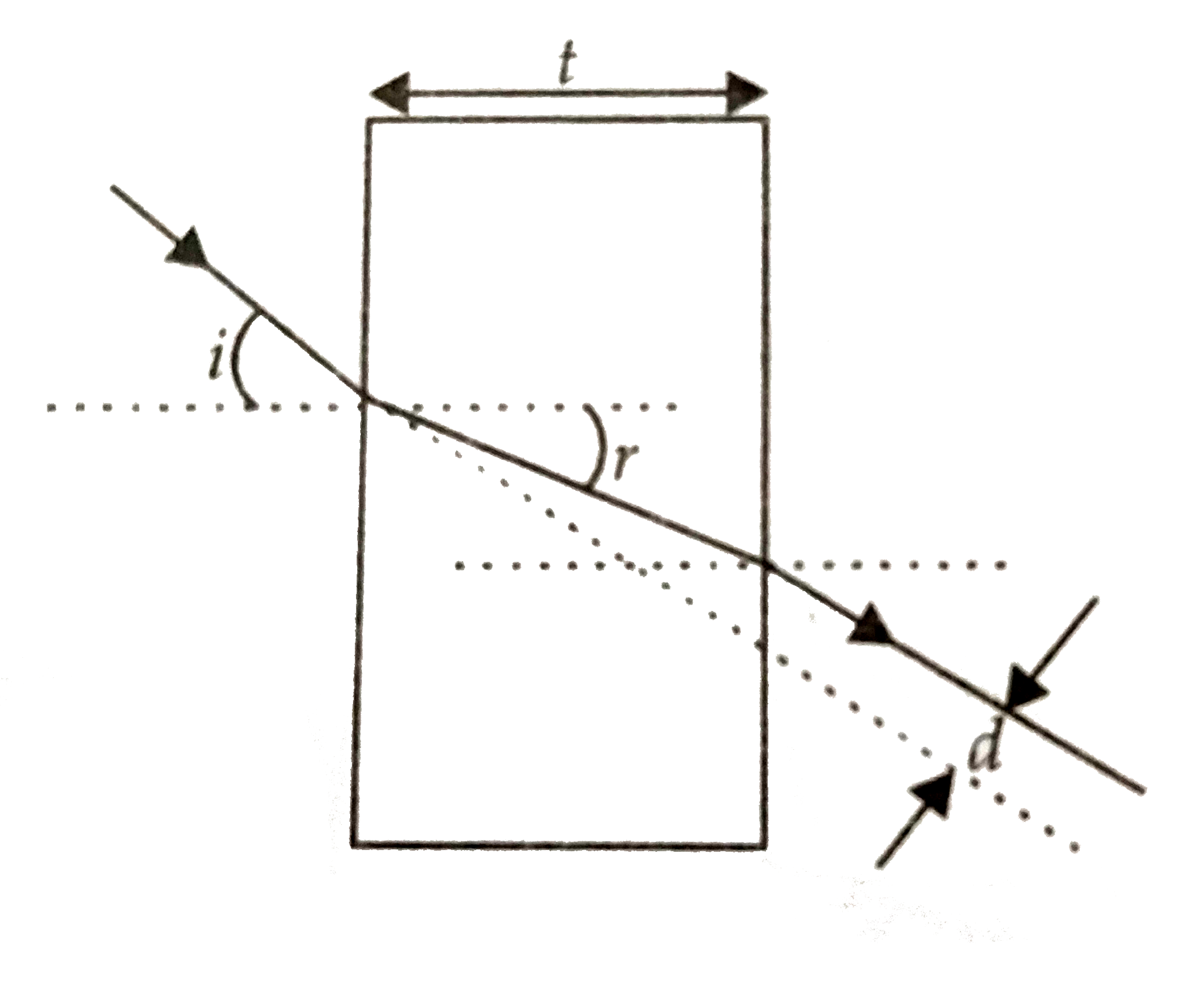
View SolutionA ray incident at a point at an angle of incidence of `60^(@)` enters a glass sphere with refractive index `sqrt(3)` and it is reflected and refracted at the farther surface of the sphere. The angle between the reflected and refracted rays at this surface is:
View SolutionThe apparent depth of a needle laying at the bottom of the tank, which is filled with water of refractive index `1.33` to a height of `12.5` cm is measured by a microscope to be `9.4 cm`. If water is replaced by a liquid of refractive index `1.63` upto the same height. What distance would the microscope have to be moved to focus on the needle again ?
View SolutionA point luminous object (O) is at a distance `h` from front face of a glass slab of width d and of refractive index `mu`. On the back face of slab is a reflecting plane mirror. An observer sees the image of object in mirror as shown in figure. Distance of image from front face as seen by observer will be
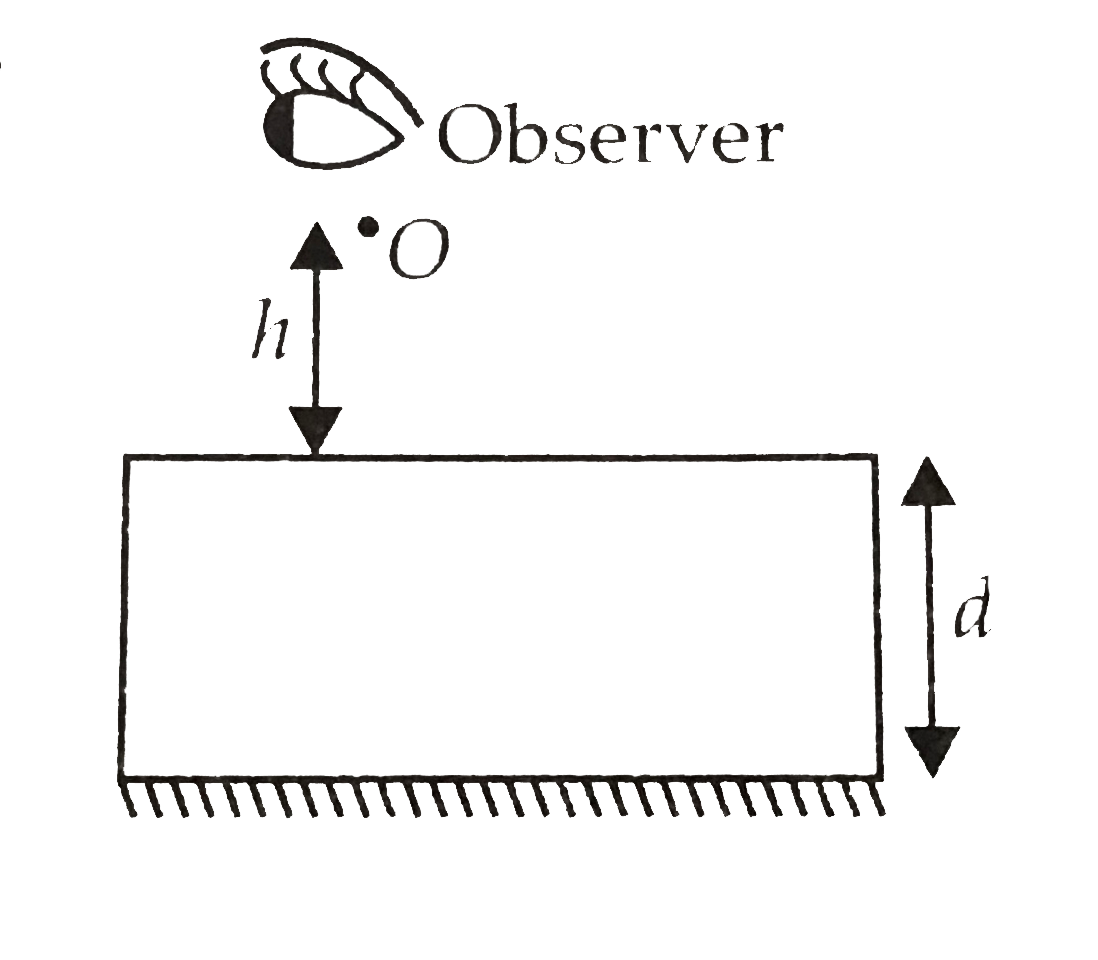
View SolutionA vesse of depth x is half filled with oil of refractive index `mu_(1)` and the other half is filled with water of refrative index `mu_(2)`. The apparent depth of the vessel when viewed above is
View SolutionThree immiscible liquids of densities `d_1 gt d_2 gt d_3` and refractive indices `mu_1 gt mu_2 gt mu_3` are put in a beaker. The height of each liquid column is `(h)/(3)`. A dot is made at the bottom of the beaker. For near normal vision, find the apparent depth of the dot.
View SolutionA tank is filled with water to a height of `15.5 cm`. The apparent depth of a needle lying at the bottom of the tank is measureed by a microscope to be `8.5 cm`. If water is replaced by a liquid of refractive index `1.94` upto the same height by what distance would the microscope have to be moved to focus on the needle again ?
View SolutionFor a total internal reflection, which of the following is correct ?
View SolutionLight travels in two media A and B with speeds `1.8 × 10^(8) m s^(–1) and2.4 × 10^(8) m s^(–1)` respectively. Then the critical angle between them is
View SolutionCritical angle of glass is `theta_(1)` and that of water is `theta_(2)`. The critical angle for water and glass surface would be `(mu_(g)=3//2, mu_(w)=4//3)`
View SolutionCritical angle for light going from medium (i) to (ii) is `theta` . The speed of light in medium (i) is v then speed in medium (ii) is
View SolutionA ray of light travelling in a transparent medium f refractive index `mu`, falls on a surface separating the medium from air at an angle of incidence of `45^(@)`. For which of the following value of `mu` the ray can undergo total internal reflection ?
View SolutionA point source of light is placed at a depth of h below the surface of water of refractive index `mu`. A floating opaque disc is placed on the surface of water so that light from the source is not visible from the surface. The minimum diameter of the disc is
View SolutionMirage' is a phenomenon due to
View SolutionFrom a point source a light falls on a spherical glass surface (`mu = 1.5` and radius of curvature `= 10 cm`). The distance between point source and glass surface is `50 cm`. The position of image is
View SolutionAn air bubble in a glass sphere `(mu = 1.5)` is situated at a distance `3 cm` from a convex surface of diameter `10 cm`. At what distance from the surface will the bubble appear ?
View SolutionA convex refracting surface of radius of curvature `20 cm` separates two media of refractive indices `4//3 and 1.60`. An object is placed in the first medium `(mu = 4//3)` at a distance of `200 cm` from the refracting surface. Calculate the position of image formed.
View SolutionLight from a point source in air falls on a spherical glass surface. If `mu = 1.5`, and radius of curvature `= 20 cm`, the distance of light source from the glass surface is `100 cm` , at what position will the image be formed ? (NCERT Solved Example)
View SolutionA mark placed on the surface of a sphere is viewed through glass from a position directly opposite. If the diameter of the sphere is `10 cm` and refractive index of glass is `1.5`, find the position of the image.
View SolutionA biconvex lens has focal length `(2)/(3)` times the radius of curvature of either surface. Calculate refraction index f material of the lens.
View SolutionA convex lens of focal legnth `0.2 m` and made of glass `(mu = 1.50)` is immersed in water `(mu = 1.33)`. Find the change in the focal length of the lens.
View SolutionA double convex lens, lens made of a material of refractive index `mu_(1)`, is placed inside two liquids or refractive indices `mu_(2)` and `mu_(3)`, as shown. `mu_(2)gtmu_(1)gtmu_(3)`. A wide, parallel beam of light is incident on the lens from the left. The lens will give rise to
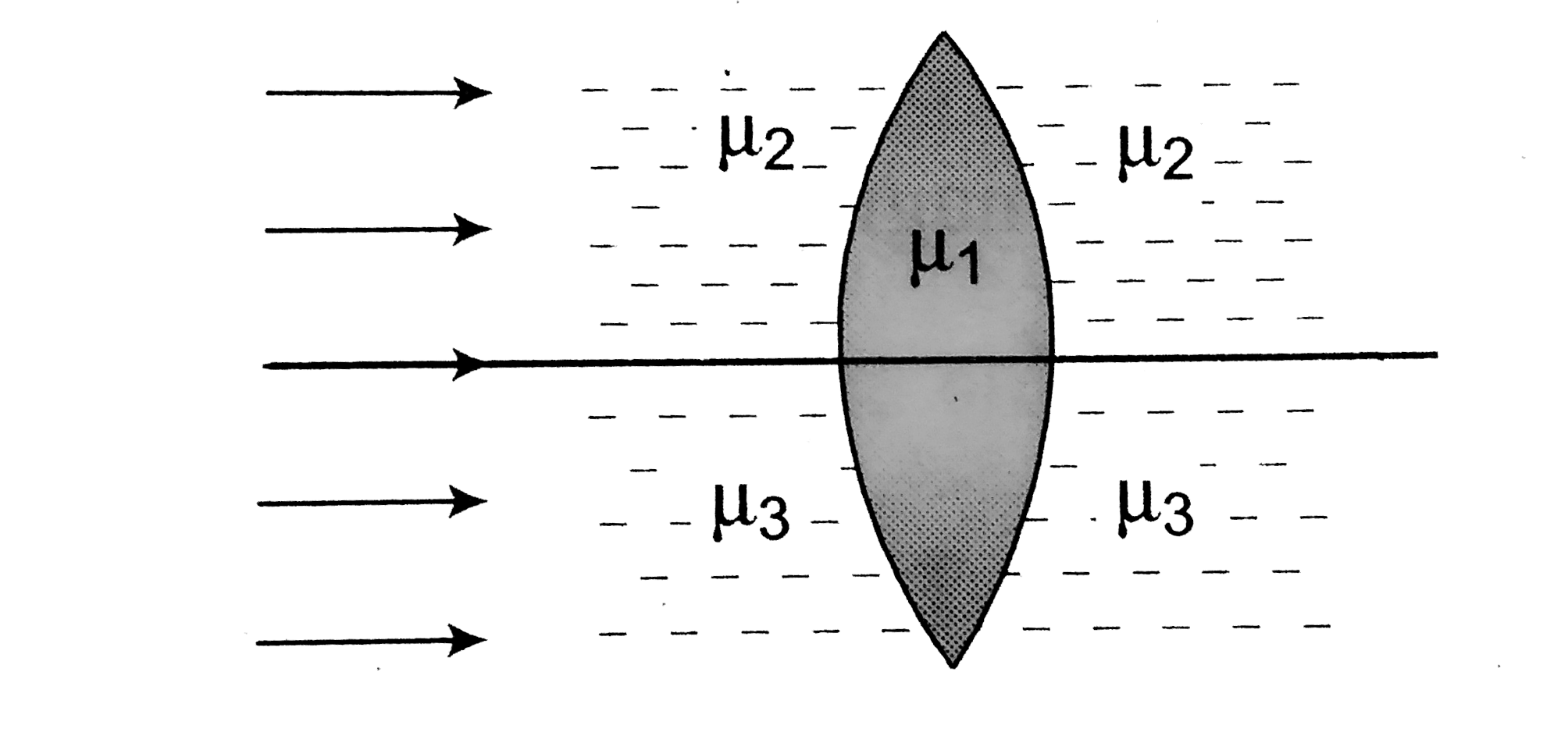
View SolutionA double convex lens is made of glass of refractive index `1.55` with both faces of same radius of curvature. Find the radius of curvature required, if focal length is `20 cm`.
View SolutionWhat is the refractive index of material of a plano-convex lens , if the radius of curvature of the convex surface is 10 cm and focal length of the lens is 30 cm ?
View SolutionThe radii of curvature of the surfaces of a double convex lens are `20 cm and 40 cm` respectively, and its focal length is `20 cm`. What is the refractive index of the material of the lens ?
View SolutionA convex lens is dipped in a liquid whose refractive index is equal to the refractive of the lens. Then its focal length will
View SolutionA convergent beam of light passes through a diverging lens of focal length `0.2 m` and comes to focus at a distance of `0.3 m` behind the lens. Find the position of the point at which the beam would converge in the absence of the lens.
View SolutionRadii of curvature of a converging lens are in the ratio `1 : 2`. Its focal length is `6 cm` and refractive index is `1.5`. Then its radii of curvature are
View SolutionA man is trying to start a fire by focusing sunlight on a piece of paper using an equiconvex lens of focal length `10 cm`. The diameter of the sun is `1.39 xx 10^(9) m` and the diameter of the sun's image on the paper is
View SolutionA square card of side length 1 mm is being seen through a magnifying lens of focal length 10 cm. The card is placed at a distance of 9 cm from the lens. The appaent area of the card thorugh the lens is
View SolutionA converging lens is used to form an image on a screen. When the upper half of the lens is covered by an opaque screen
View SolutionWhich of the following form(s) a virtual and erect image for all position of the object?
View SolutionA real image of a distant object is formed by a plano-convex lens of its principal axis. Spherical aberration
View SolutionAn object is placed at a distance of `1.5 m` from a screen and a convex lens is interposed between them. The magnification produced is `4`. What is the focal length of the lens ?
View SolutionThe image of a needle placed `45 cm` from a lens is formed on a screen placed `90 cm` on the other side of lens. Find displacement of image if object is moved `5 cm` away from lens.
View SolutionA tree is `18.0 m` away from `2.0 m` high from a concave lens. How high is the image formed by the given lens of focal length `6 m` ?
View SolutionA luminous object is separated from a screen by distance d. A convex lends is placed between the object and the screeen such that it forms a distinct image on the screen. The maximum possible focal length of this convex lens is.
View SolutionA screen is placed `90 cm` from an object. The image of the object on the screen is formed by a convex lens at two different location separated by `20 cm`. Determine the focal length of the lens.
View SolutionA lens having focal length `f` and aperture of diameter `d` forms an image of intensity `I`. Aperture of diameter `d//2` in central region of lens is covered by a black paper. Focal length of lens and intensity of image now will be respectively
View SolutionA thin convex lens of focal length `25 cm` is cut into two pieces `0.5 cm` above the principal axis. The top part is placed at (0,0) and an object placed at `(-50 cm, 0)`. Find the coordinates of the image.
View SolutionA double convex lens made of glass of refractive index `1.56` has both radii of curvature of magnitude `20 cm`. If an object is placed at a distance of `10 cm` from this lens, find the position of image formed.
View SolutionThe power of a biconvex lens is 10 dioptre and the radius of curvature of each surface is 10 cm. Then the refractive index of the material of the lens is
View SolutionA thin glass (refractive index `1.5`) lens has optical power of `-8D` in air, its optical power in a liquid medium with refractive index `1.6` will be
View SolutionThe radius curvature of each surface of a convex lens of refractive index 1.5 is 40 cm. Calculate its power.
View SolutionTwo lenses of focal lengths `20 cm and - 40 cm` are held in contact. The image of an object at infinity will be formed by the combination at
View SolutionAn eye specialist prescribes spectacles having combination of convex lens of focal length 40cm in contact with a concave lens of focal length 25cm. The power of this lens combination in diopters is
View SolutionTwo lenses of power `+ 10 D and - 5 D` are placed in contact,
(i) Calculate the focal length of the combination
(ii) where should an object be held from the combination so as to obtain a virtual image of magnification `2` ?
View SolutionA real image of an object is formed at a distance of `20 cm` from a lens. On putting another lens in contact with it, the image is shifted `10 cm` towards the combination, Determine the power of the second lens.
View SolutionA concave lens is placed in contact with a convex lens of focal length `25 cm`. The combination produces a real image at a distance of `80 cm`, when an object is at a distance of `40 cm`. What is the focal length of concave lens ?
View SolutionTwo identical glass `(mu_(g)=3//2)` equiconvex lenses of focal length f are kept in contact. The space between the two lenses is filled with water `(mu_(w)=4//3)` . The focal length of the combination is
View SolutionA convex lens of focal length 15 cm is placed on a plane mirror. An object is placed at 30 cm from the lens. The image is
View SolutionIn the given figure, the radius of curvature of curved surface for both the plano-convex and plano-concave lens is 10 cm and refractive index for both is `1.5`. The location of the final image after all the refractions through lenses is
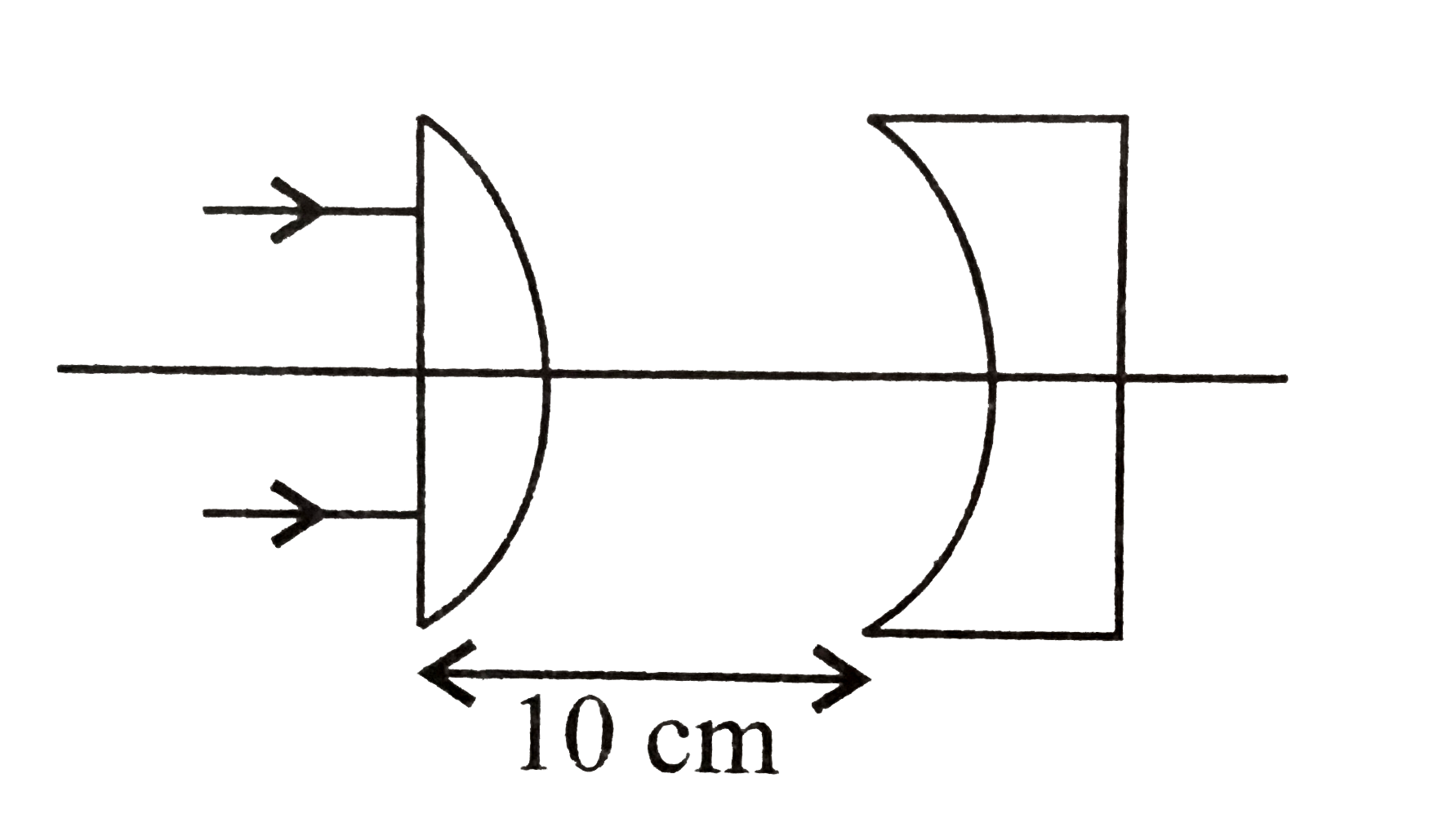
View SolutionA convex lens of radii of curvature 20cm and 30 cm respectively. It is silvered at the surface which has smaller radius of curvature. Then it will behave as `(mu_(g) = 1.5)`
View SolutionA concave mirrorr of focal length `f_(1)` is placed at a distance of `d` from a convex lens of focal length `f_(2)`. A beam of light coming from infinity and falling on this convex lens-concave mirrorr combination returns to infinity. The distance `d` must equal.
View SolutionA plano convex lens has focal length `f = 20 cm`. If its plane surface is silvered, then new focal length will be
View SolutionTwo beam of red and violet colors are made to pass separately through a prism (angle of the prism is `60^(@)`). In the position of minimum deviation, the angle of refraction will be
View SolutionA ray of light passes through an equilateral prism (refractive index `1.5`) such that angle of incidence is equal to angle of emergence and the latter is equal to `3//4 th` of the angle of prism. Calculate the angle of deviation.
View SolutionA ray of light is incident at small angle I on the surface of prism of small angle A and emerges normally from the oppsite surface. If the refractive index of the material of the prism is mu, the angle of incidence is nearly equal to
View SolutionThe angle of minimum deviation for prism of angle `pi//3 is pi//6`. Calculate the velocity of light in the material of the prism if the velocity of light in vacuum is `3 xx 10^8 ms^-1`.
View SolutionThe angle of minimum deviation for a glass prism with `mu=sqrt3` equals the refracting angle of the prism. What is the angle of the prism?
View SolutionA ray of light is incident at `60^(@)` on one face of a prism of angle `30^(@)` and the emergent ray makes `30^(@)` with the incident ray. The refractive index of the prism is
View SolutionA small angled prism `(mu = 1.62)` gives a deviation of `4.8`. Calculate the angle of prism.
View SolutionWhich of the following colours of white light deviated most when passes through a prism ?
View SolutionWhite light is incident normally on a glass slab. Inside the glass slab,
View SolutionWhich light rays undergoes two internal reflection inside a raindrop, which of the rainbow is formed?
View SolutionWhich of the following satatment is correct ?
View SolutionWhen objects at different distances are seen by the eye, which of the following remains constant?
View SolutionAn under-water swimmer cannot see very clearly even in absolutely clear water because of
View SolutionThe nearer point of hypermetropic eye is `40 cm`. The lens to be used for its correction should have the power
View SolutionWhen a telescope is in normal adjusment, the distance of the objective from the eyepiece is found to `100 cm`. If the magnifying power of the telescope, at normal adjusment, is `24` focal lengths of the lenses are
View SolutionA compound microscope consists of an objective lens with focal length `1.0 cm` and eye piece of the focal length `2.0` cm and a tube `20 cm` from eye lens. Now final image is formed at the near point of eye, so find the magnifying power of microscope.
View SolutionIn a compound microscope, the focal lengths of two lenses are `1.5 cm` and `6.25 cm` an object is placed at `2 cm` form objective and the final image is formed at `25 cm` from eye lens. The distance between the two lenses is
View SolutionA person with a normal near point `(25 cm)` using a compound microscope with an objective of focal length `8.0 mm` and eye piece of focal length `2.5 cm` can bring an object placed `9.0 cm` from the objective in sharp focus. What is the separation between the two lenses ? Calculate the magnifying power of the microscope ?
View SolutionThe final image in an astronomical telescope adjustment, a straingt black line of length L is drawn on the objective lens. The eyepiece forms a real image of this line. The length of this image is l. The magnification of the telescope is
View SolutionIn an astronomical telescope in normal adjustment a straight black line of length `L` is drawn on inside part of objective lens. The eye piece forms a real image of this line. The length of this image is `I`. The magnification of the telescope is
View SolutionThe focal length of the lensese of an astronomical telescope are 50 cm and 5 cm. The length of the telescope when the image is formed at the least distance of distinct vision is
View SolutionA small telescope has an objective lens of focal length `144 cm` and an eye-piece of focal length `6.0 cm`. What is the magnifying power of the telescope ? What is the separation between the objective and the eye-piece ?
View SolutionAn astronomical refractive telescope has an objective of focal length 20 m and an eyepiece of focal length 2 cm. Then
View SolutionA gaint refrecting telescope at an observatory has an objective lens of focal length `15 m`. If an eye piece lens of focal length `1 cm` is used, find the angular magnification of the telescope.
If this telescope is used to view the moon, what is the diameter of image of moon formed by objective lens ? The diameter of the moon is `3.42 xx 10^6 m` and radius of lunar orbit is `3.8 xx 10^8 m`.
View SolutionA small telescope has an objective lens of focal length 140 cm and an eyepiece of focal length 5.0 cm. what is the magnifying power of the telescope for viewing distant objects when
(a) the telescope is in normal adjustment (i.e, when the final image is at infinity ),
(b) The final image is formed at the least distance of distinct vision (25 cm )
View SolutionA reflecting type telescope has a large concave spherical mirror of radius of curvature `80 cm` as objective. What is the magnifying power of telescope if eye piece used has a focal length of `1.6 cm` ?
View SolutionA giant telescope in an observatory has an objective of focal length 19 m and an eye-piece of focal length `1.0 cm`. In normal adjustment, the telescope is used to view the moon. What is the diameter of the image of the moon formed by the objective? The diameter of the moon is `3.5 xx 10^(6)m`. and the radius of the lunar orbit round the earth is `3.8 xx 10^(8) m`.
View SolutionA ray of light travelling in the direction `(1)/(2)``(hati,+sqrt3hatj)` is incident on a plane mirror. After reflection, it travels along the direction `(1)/(2)(hati-sqrt3hatj)` . The angle of incidence is
View SolutionThe number of capital latters such as `A,B,C,D"….."` which are not latterally inverted by a plane mirror ?
View SolutionTwo mirrors at an angle `theta^(@)` produce 5 images of a point. The number of images produced when `theta` is decreased to `theta^(@) - 30^(@)` is
View SolutionA man stands symmetrically between two large plane mirrors fixed to two adjacent walls of a reactangular room. The number of images formed as
View SolutionTwo plane mirrors `M_(1) ` and `M_(2)` are inclined at angle as shown in Figure . A ray of light1, which is parallel to `M_(1)` , strike `M_(2)` and after two reflections, ray 2 becomes parallel to `M_(2)`. Find the angle `theta` .
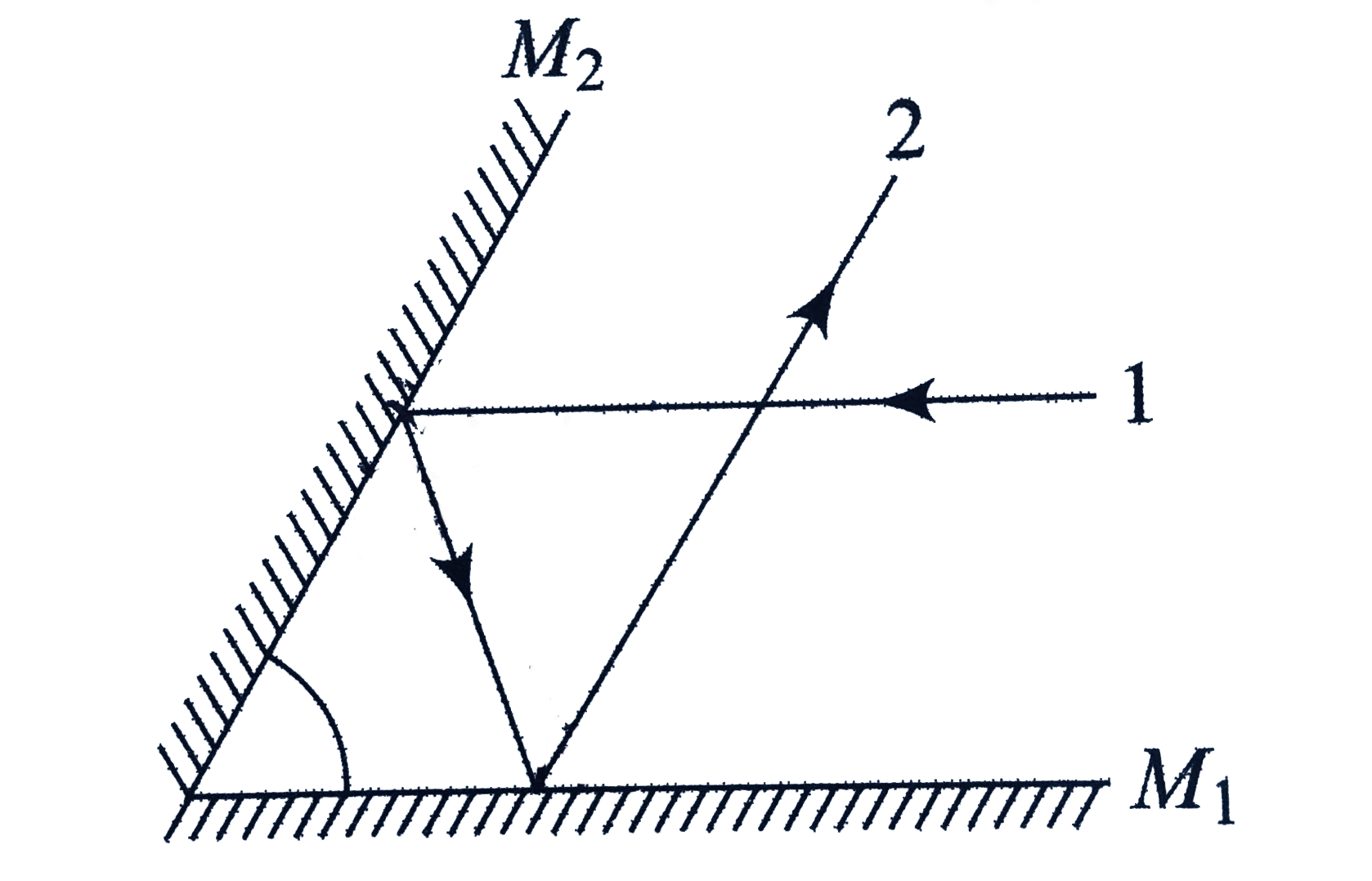
View SolutionTwo plane mirrors are placed parallel to each other at a distance L apart. A point object O placed between them, at a distance `L//3` from one mirror. Both mirrors form multiple image. The distance between any two images cannot be
View SolutionFour identical mirror are made to stand vertically to form a square arrangement as shown in a top view. A ray starts from the midpoint M of mirror AD and after two reflections reaches corner D. Then, angle `theta` must be

View SolutionLight incident normally on a plane mirror attached to a galvenometer coil reflects backward as shown in figure. A current in the coil produes a deflection of `3.5^(@)` if the mirror. The displacement of the reflected spot of light on a screen placed `2.0 m` away is
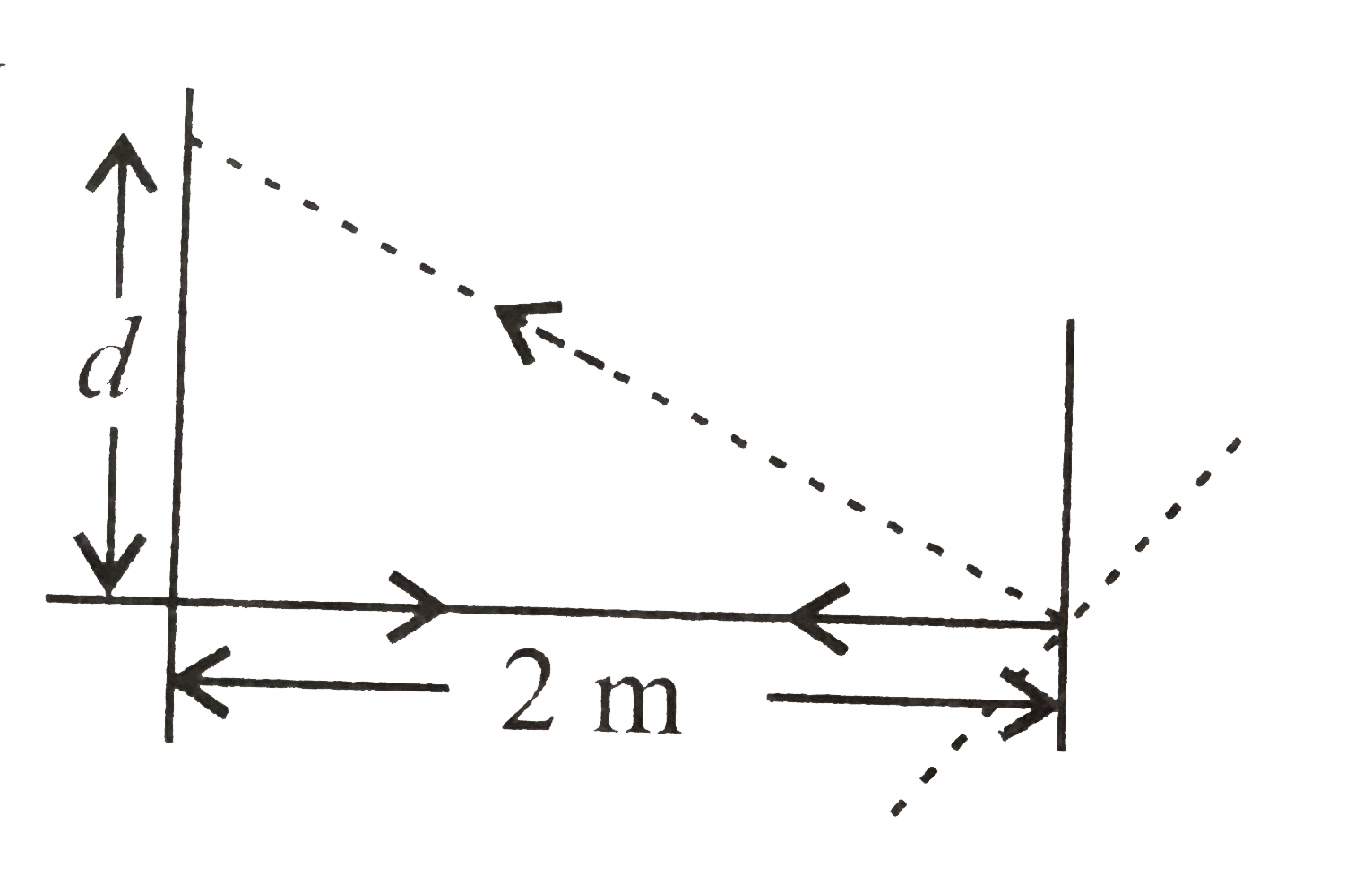
View SolutionA plane mirror is placed along the x-axis facing negative y-axis. The mirror is fixed, A point object is moving with `3hati+4hatj` in front of the plane mirror. The relative velocity of image with respect to its object is
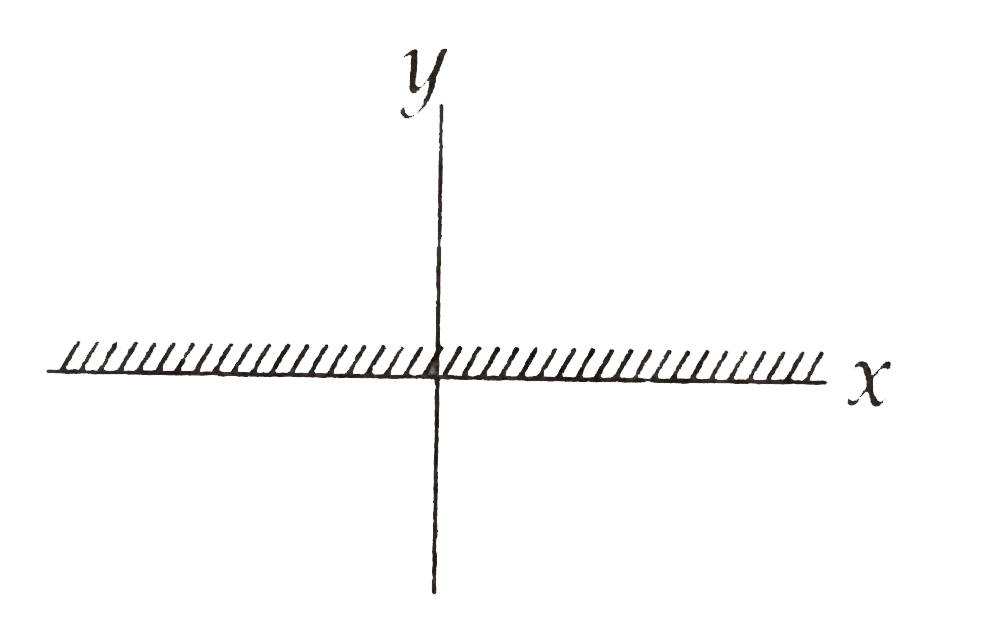
View Solution
MULTIPLE CHOICE QUESTIONS questions and complete solutions for chapter RAY OPTICS AND OPTICAL INSTRUMENTS of MTG PHYSICS (ENGLISH) of Class 12
All Exercises from NCERT FINGERTIPS Class 12 PHYSICS RAY OPTICS AND OPTICAL INSTRUMENTS
- ASSERTION AND REASON
- HIGHER ORDER THINKING
- Higher Order Thinking Skills
- Miscellaneous
- MULTIPLE CHOICE QUESTIONS
- NCERT EXAMPLAR PROBLEMS
- NCERT Exemplar
- Optical Instruments
- Reflection At Spherical Surfaces And By Lenses
- Reflection Of Light By Spherical Mirrors
- Refraction
- Refraction Through A Prism
- Some Natural Phenomena Due To Sunlight
- Total Internal Reflection